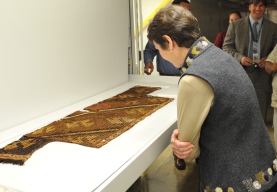Smithsonian-sponsored training sparks HSI special agents' enthusiasm
Learning the nuts and bolts of investigating crimes involving cultural property, art and antiquities

This year, U.S. Immigration and Customs Enforcement (ICE) Homeland Security Investigations (HSI) special agents returned ceramic antiquities to Peru, artwork to Italy, fossils to China and a sarcophagus to Egypt. Customs laws allow agents to seize national treasures, especially if they have been reported lost or stolen. They then work with experts to authenticate the items, determine their true ownership and return them to their countries of origin.
These cases can be exceedingly complex. Special agents must know how to properly handle, photograph, document and safely store ancient antiquities and art. They need to develop a working knowledge of ancient cultures and civilizations. They need to understand and converse in the jargon spoken among archaeologists, anthropologists and art historians. They must know and understand applicable laws. They need to search cultural heritage databases and network with experts who can help them further their investigations.
This fall, ICE HSI agents participated in a training workshop at the Smithsonian Museum Conservation Institute (MCI) in Suitland, Md. The workshop focused on preventing illicit trafficking and protecting cultural heritage - items that ICE HSI agents could potentially investigate.
"It made sense to have the training at the Smithsonian because the Institution has collections that represent all parts of the world," said Rae Beaubien, head of conservation at the Smithsonian MCI.
Picture a network of laboratories where scientists and conservators conduct research to unlock mysteries of the universe. At the MCI, staff specialists have worked with collaborators across the Smithsonian Institution to analyze an astronaut's glove with moon dust trapped inside; determine that migratory, not local, geese struck the plane that crashed into the Hudson River in 2009; and trace century old links between elephants, humans and land use.
The workshop provided HSI Senior Special Agents (SSA) with the tools they need to hone their skills in investigating crimes involving cultural property, art and antiquities -investigations overseen by HSI's National Intellectual Property Rights Coordination Center (IPR Center) in Arlington, Va.
The workshop broke each of these topics down into a logical and organized format, while experienced agents shared their knowledge and investigative paths that brought their cases to successful conclusions.
"I've always had a passion for art, but was a bit intimidated to work these complex cases," said Lennis "Duck" Barrois, Jr., a special agent with the Special Agent in Charge (SAC) office in New York. "This program has eliminated all fears and doubts, and I look forward to working these awesome cases."

Touring the MCI was of particular interest to the training participants who listened intently as experts explained and demonstrated the high-tech wizardry applied to historic objects, works of art and specimens of the natural world. For instance, new imaging techniques allow scientists to zoom in like never before and capture per pixel representations of paintings and photos.
The tour of the Smithsonian's massive anthropology collections, stored in the same building as the MCI, was equally fascinating. In five pods, some the size of football fields, the Smithsonian stores millions of items in carefully organized storage units. Tall metal cabinets labeled "Egypt," "Peru" and "Ecuador," to name a few nations, encased ancient pottery, baskets, rudimentary tools, hand-made apparel and other objects all made by people of past civilizations.
"The MCI captured our agents' interest…the type of interest that leads directly to the proactive development of cultural property investigations," said Craig Karch, HSI Special Agent and Program Manager. This is the third such training session hosted by the Smithsonian. Plans are in the works for future sessions.
Learn more about ICE's Cultural Property, Art and Antiquities Investigations.

No comments:
Post a Comment